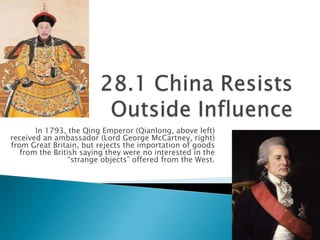
China Rejects British Trade Due to Self-Sufficiency
- 1. In 1793, the Qing Emperor (Qianlong, above left) received an ambassador (Lord George McCartney, right) from Great Britain, but rejects the importation of goods from the British saying they were no interested in the “strange objects” offered from the West.
- 2. China rejected offers of trade from the West because it was largely self-sufficient in the ways: ◦ Agriculture Quick-growing strain of rice since the 11th century Maize, sweet potatoes, and peanuts since 17th/18th centuries ◦ Natural Resources Salt, tin, silver, and iron ◦ Manufacturing Silks, high-quality cottons, fine porcelain
- 3. Foreigners were only allowed to trade at the southern port of Guangzhou. Trade balance was in China’s favor. European merchants decide to sell the habit-forming drug opium (a narcotic derived from the opium poppy plant) in China to obtain a favorable trade balance. By 1835, as many as 12million Chinese were addicted
- 4. The Qing emperor was angry about the drug trade coming from the British. In 1839 the Emperor’s advisor writes a letter to Queen Victoria demanding the drug trade stop. The Opium War breaks out between Britain and China in 1839, but is fought mainly at sea. The Chinese are no match for Britain’s steam-powered gun boats. The Treaty of Nanjing is signed in 1842.
- 5. British get Hong Kong
- 6. The British enjoyed extraterritorial rights, which meant that British citizens were not subject to Chinese laws, but, if accused of a crime in Chinese trading ports, but would only be tried by British courts. In 1844 the U.S. signed a the Treaty of Wanghia in which American citizens were given extraterritorial rights as well. This arrangement protected Europeans and Americans from prosecution for drug smuggling.
- 7. Population grew to 430 million by 1850, a 30 percent increase in 60 years. Food production did not keep up with this increase. Discouragement increased opium addiction Chinese began to rebel against the Qing Dynasty
- 8. Hong Xiuquan began recruiting followers to help him build a “Heavenly Kingdom of Great Peace.” Hong referred to himself as the “brother of Jesus” (fact from AP textbook). His movement was called the Taiping Rebellion. By 1850s, Hong organized a massive peasant army and took control over large areas of southeastern China. 1853 Hong captured Nanjing and made it his capital. Qing imperial troops and British and French forces all launched attacks against the Taiping government. By 1864 the rebellion was put down, but at least 20 million people died in the rebellion.
- 9. Chinese government has both internal and external pressures. ◦ Internal Taiping Rebellion Other rebellions ◦ External Pressure from foreign powers was increasing Debates emerged in the Qing court ◦ Some leaders wanted to reform and modernize according to Western ways. ◦ Some clung to traditional Chinese ways
- 10. Dowager Empress Cixi held power in China from 1862-1908. She was committed to Chinese traditional values. She backed some attempts at reform like the “Self- Strengthening Movement” which wanted to update China’s educational system, diplomatic service, and military. The movement had mixed results.
- 11. Foreign nations attack China and through treaties gain more control over China’s economy. Many of Europe’s major powers and Japan gain spheres of influence—areas in which the foreign nation controlled trade and investment. The U.S., having no sphere of influence, declared its Open Door Policy demanding free trade for all nations in China. Britain and other European nations agree to this demand.
- 13. 1898, Emperor Guangxu introduced measures to modernize China’s educational system, economy, military, and government Qing officials saw these innovations as a threat and called on the Dowager Empress to act. She has Guangxu arrested and reverses his reforms. Emperor Guangxu (center)
- 14. Resentful of the privileges of foreigners, a secret organization called the Society of Righteous and Harmonious Fists is formed. They are called the “Boxers” for short. The carry out a campaign against foreigners known as the Boxer Rebellion. 1900—the Boxers descend on Beijing and surround the European section of the city. The Dowager Empress expressed support for the Boxers, but did not back them militarily. The Boxers murder Europeans, missionary, and diplomats, as well as many Chinese Christians, both Protestant and Catholic. The Boxers, by Johannes Koekkoek, circa 1900
- 15. August 1900—a multinational force of 19,000 troops marches on Beijing and defeats the Boxers. Though the Boxer Rebellion failed to expel foreign influence, the Chinese have a renewed sense of nationalism and realization they must resist foreign influence. A Boxer during the revolt.
- 16. This is the name given to the 182 Protestant Missionaries (of several denominations) and 500 Chinese Protestants who were murdered during the Boxer Rebellion. In 1901, allied nations who helped put down the rebellion demanded compensation for loss of life and property, but China Inland Mission founder James Hudson Taylor refused to accept any such payment for the loss of his missionaries or mission property “in order to show the meekness of Christ to the Chinese.” Missionaries killed in the Boxer Rebellion who worked for China Inland Mission. James Hudson Taylor- Founder of China Inland Mission
- 17. Both the Roman Catholic and Eastern Orthodox Churches recognize Chinese citizens killed in the 19th and 20th centuries, most of whom were killed in the Boxer Rebellion. These martyrs are formally venerated by those churches.
- 18. 1905 Dowager Empress sends out a delegation to study the operation of different governments. 1906 officials recommend China’s government be restructured. A constitutional monarchy was suggested. A national assembly was convened within a year, but change was slow. In 1908 the court promised a constitutional government by 1917. China would continue to have unrest for the next four decades.
